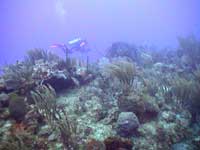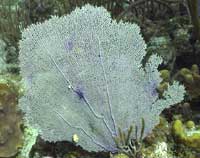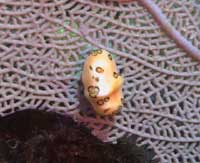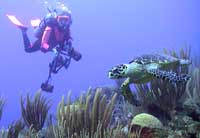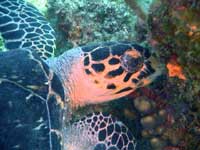 |
||||||||||||||||||||||
Today Cori is taking us to investigate a coral reef on the opposite side of the place we dove on DAY 4. This is front side of Alice's Backside. It is called "Ginger Steps". Even though we are near Alice's Backside this reef is very different. For one thing this reef is like gigantic stair steps. This reef here is more rocky with less of the large corals. We do see a lot more different kinds of soft corals. These corals are soft and flexible. The soft corals wave back and forth as they are pushed around by the sea currents. Some corals need more nutrients than others. Some need more sunlight. Some are damaged by waves and strong currents. The differences between the rougher side (windward) of the island and the calmer side (leeward) of the island most be enough to affect what kind of corals survive best in these different areas. We set down our DVs to explore the reef more closely. One of the soft corals we see most commonly on the reefs on both sides of Ginger Island is the sea fan. It looks like a big fan that people used to fan themselves with. Most of the sea fans we see are about 1-2 feet across, but we have seen some sea fans about 4 feet across! A sea fan is made like a baseball catcher's mitt. A sea fan catches plankton floating by. Like hard corals a sea fan is made of hundreds or thousands of tiny coral polyp animals. These coral polyps look like tiny sea anemones. They use their tentacles to sting plankton floating by that they catch for food. Hard coral polyps each have small, cup-like skeletons that are cemented together and makes the corals hard. Soft coral polyps don't have outside skeletons, but have an internal, mesh-like skeleton that they all share. The coral polyps live on the outside of this mesh-like skeleton that is hard and flexible, like your finger nails. Looking closely at a purple sea fan we see a small shell. It is about the size and half the length of your little finger. It is a flamingo tongue cowry! These sea snails eat the outside skin and polyps of the sea fan. Flamingo cowries are not really a danger to the coral reef. Even though it is eating the sea fan the cowry is not doing any serious damage to it. The skin will regrow and the sea fan will continue growing. We see something swimming near the reef. It's a sea turtle! Fortunately the sea turtle is not swimming very fast, because we have left our DVs on the bottom in our rush to swim close to the turtle. She slowly swims along as we swim next to her, almost an arm's reach away! We can tell it is a girl turtle because the tail does not stick out from under the shell. Only boys' tails stick out from under their shells. We can also tell, from the pattern on its shell, and its bird-like beak, that it is a hawksbill turtle. It is about 2 feet long. Hawksbill turtles can grow to over 3 feet long and weigh up to 133 pounds. The turtle swims with us for a while, but we can see it is looking around -- probably for something to eat. Hawksbill turtles eat the strangest things -- sponges! Sponges are a colony of tiny animals. Most animals do not eat sponges because sponges taste really bad. For some reason, of all the turtles in the world, the hawksbills are the only ones that like to eat sponges! (Tomorrow we will find some sponges to show you.) The hawksbill spies a tasty looking sponge. We follow the turtle as it drops down to reach the sponge. The turtle stops, stretches out its neck and uses its sharp beak to bite off a chunk of orange sponge. The turtle continues to slowly munch on the sponge as we swim back to our DVs and cruise back to the boat. Tomorrow join us as we show you the amazing world of sponges. If you thought Sponge Bob Square Pants was strange, just wait until we tell you the real truth about sponges! Best Fishes, . |
TODAY'S DATA Ginger Steps, Ginger Is. Position: 18º 23' N / 64º 28' W In the distance Karen swims over the reef. You can see most of the reef is covered with different kinds of soft corals.
Notice the small beige spot on the bottom, left side of the this sea fan (about 1 foot tall). It is a flamingo tongue cowry.
The flamingo tongue cowry slowly crawls on the sea fan, eating the polyps. The spots are on the skin (mantle) of the flamingo tongue cowry.
A hawksbill sea turtle (about 2 feet long) slowly swims in front of Karen looking for food. Karen is holding one of our underwater cameras.
We watch as this hawksbill turtle munches on some orange sponge. |
|||||||||||||||||||||
home | basecamp | archives | library | other expeditions | kids' page | contact us © 2002, The Ocean Adventure All rights reserved. |
